Why should you absolutely visit Luxembourg?


Luxembourg also offers an extensive network of bicycle paths and the densest networks of trails in Europe and is one of the most favourite destinations for those who love sport and adventure.
Because you can experience a lot in this extremely dynamic and multicultural country where the distances are short, transport are free and the impressions are great. A small destination at the heart of Europe with deep historical roots, that is constantly evolving and reinventing itself. Visit historic sites and museums; enjoy incredible unspoilt beautiful landscapes, fairy-tale castles, sports in action, culinary highlights, wellness, relaxation and cultural depth.

Luxembourg City
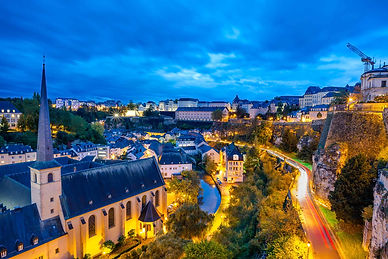

A vibrant, cosmopolitan, culturally exciting, green capital in the heart of Europe.
Built on impressive historical foundations, experience history as well as culture and shopping for all tastes.
In a city where you can meet people from 170 nations, it’s no wonder that so many of the languages of the world are heard everywhere. Everything is within walking distance, restaurants, cafés, bars, museums and shops.
As the entire Old Town is a UNESCO World Heritage site, relaxing strolls and fascinating insights into the history of the country and the city are virtually inseparable.
Take a walk along the Corniche, hailed as “Europe’s most beautiful balcony”.
Discover the bastions and casemates of Luxembourg City’s fortifications, the underground tunnels carved into the solid rock, a reminder of the period between the 16th and 19th centuries, when Luxembourg was one of the most important fortresses in Europe.
Take the lift to the Grund or to Pfaffenthal and discover a city on many levels that surprises you around every corner with green oases.
You could easily spend an entire day meandering through the historical city center, checking out the buildings and treating yourself to gourmet food in one of its many restaurants.
Visit some of the many museums, Luxembourg has some sixty museums, which highlight its centuries-old existence, from the Palaeolithic to the immediate present, from the Stone Age to iron ore. Housed in historic buildings, often listed or with innovative architecture, they also reflect the country's openness to the arts, culture and sciences: from Celtic and Roman sculptures to national and international contemporary works, and from natural and exact sciences to the latest technologies.
The so-called "Museum Smile" is home to seven museums, a mile that forms a smile when plotted on the map.
Art and culture can also be found in numerous other galleries and shops such as those in the Fëschmaart quarter of the Old Town.
The Palais Grand-Ducal is a a fine example of Flemish Renaissance architecture. Place Guillaume II is famous for flowers, food, and handicrafts.
Vianden
Embedded in the splendid landscape of the Éislek, Vianden had tourist tradition for more than a hundred years. Like the famous French poet Victor Hugo, thousands of visitors are charmed each year by the narrow and paved lanes, the gothic churches, the ramparts and fortified towers of the small medieval town, dominated by the magnificent castle. Meanwhile, well-maintained tracks, offering spectacular panoramic views, invite the passionate walkers to meet the fauna and flora in the wide forests and narrow valleys. Vianden Castle is one of the largest fortified castles in the country. Visitors are enthralled with complex stonework, spires, turrets, and eye-catching colours. In the summer, the castle hosts its yearly Medieval Festival.
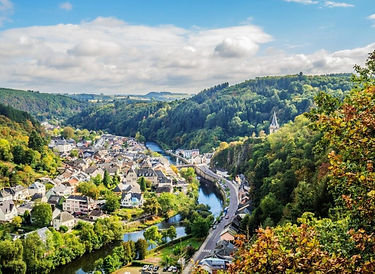

Clervaux
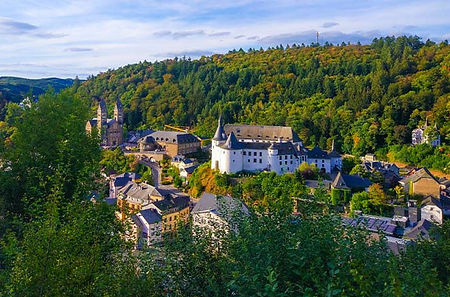

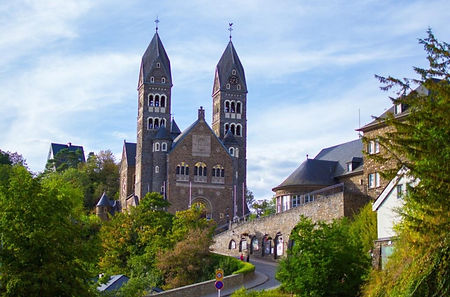
Located in the middle of the Éislek region, the city of Clervaux is a frequently visited location. Lovers of historical architecture will get their money's worth here: the town is dominated by the large Benedictine abbey St Maurice, the parish church Sts Côme et Damien and a castle from the 12th century. Restored after its destruction in World War 2, the castle now houses three permanent exhibitions: The world-famous photo exhibition "The Family of Man", which is part of the UNESCO World Documentary Heritage, the Museum of models of the Castles and Palaces of Luxembourg and the Museum of the Battle of the Bulge. Also, the city's pedestrian zone with its small shops, cafés and terraces invites you to shop and relax. Clervaux Castle is perched on the slopes of a rocky promontory above the city. Its origins date back to the 12th century. After its entire destruction on December 17th 1944 during the Battle of the Bulge in the Second World War, the government of Luxembourg acquired the castle and restored it completely.
Esch-Sur-Sûre
Set in a valley of the Sûre river in the Éislek, the village of Esch-sur-Sûre is situated in a meander of the river at the foot of the ruins of the oldest castle in Luxembourg. The ruins of the feudal castle, which is freely accessible, offer a wonderful view of the village and its narrow streets that have barely changed since the Middle Ages. Western of the village lies the Upper-Sûre Lake, which is a popular attraction in summer.The origins of the castle of Esch-sur-Sûre date back to 774. The castle foundations date back to the year 927, when Maingaud and his wife Hiletrude from the Abbey in Stavelot acquired Esch-sur-Sûre to build a fortified castle there.
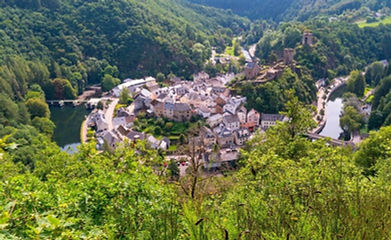

Beaufort
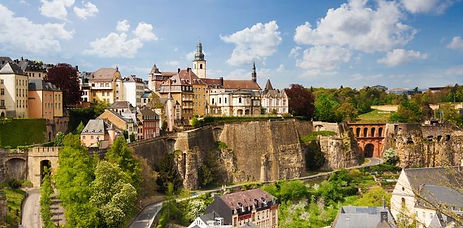

Situated on a plateau surrounded by vast forests, with amazing rock formations and streams babbling over picturesque waterfalls. Renaissance castle, impressive ruins of a 12th century castle, neo-gothic church.Kirsch, "Cassero" and "Vieille Prune" from Beaufort castle are very popular specialities.A network of footpaths leads through the Valleys of the Hallerbach and the Sure, towards Dillingen and Grundhof.
Echternach
The historical and cultural center of the Mullerthal Region - Luxembourg's Little Switzerland as well as the oldest city of Luxembourg has retained its medieval ambience: labyrinthine streets, remains and towers of the ancient city wall and a marketplace with a Gothic town house take the visitor back in time. In the center there is a museum of prehistory and at the lake there are the remains of the largest Roman villa north of the Alps.
The city of Echternach also has a wide cultural offer with folklore festivals and flea markets. The Trifolion is a generously designed cultural and congress center. A large recreational area with lake, bike and hike trails and an adventure playground make a holiday here worthwhile.
The origins of the town wall go back to the 10th century.
The former courthouse “Denzelt” belongs to the main attractions of Echternach. Gothic and Renaissance elements mingle on the facade.
The building of the HIHOF houses the interesting museum of prehistory.
The imposing Romanesque Basilica was originally built in 700, destroyed by a big fire in 1031 as well as during WW II and rebuilt during the 1950’s. Its crypt houses the tomb of the only saint buried in Luxembourg, Saint Willibrord.

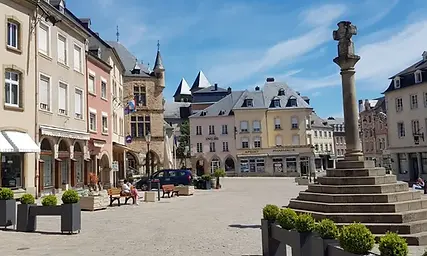
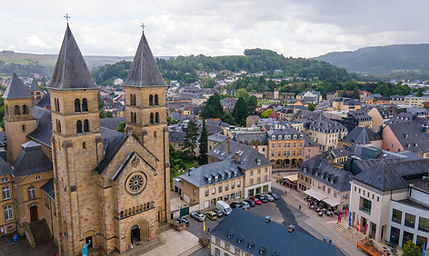
Esch-Sur-Alzette
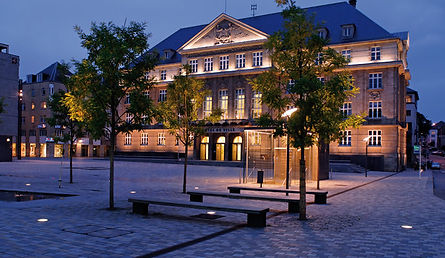

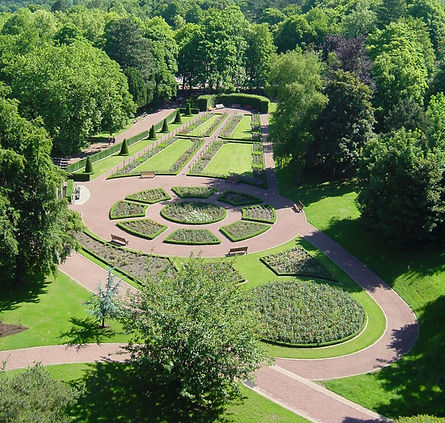
Cosmopolitan city with a lively past, Esch-sur-Alzette is well-known for its architectural charms (the architects Violet le Duc, Joseph Stübben, Gottfried Böhm and Peter Rice have worked here) and its large shopping facilities. The second largest town of the country lies at 17 km from the capital city and at 25 km from the airport.
A choice of cultural attractions awaits the visitors: the National Museum of the Resistance, the metallurgical factories, Berwart tower, monuments, architectural walk in the city centre, Belvédère, parks (Stübben), St. Joseph's church, grotto of O.L. of Lourdes, city hall, local theatre with programs meeting everyone's taste, art galleries, libraries, music conservatory and numerous events well-known far beyond the border. Its history and that of the adjacent areas can be traced back to more than 5.000 years.
The recreation centre at Galgenberg offers a beautiful park, marked walking paths, rose-garden, waterfall and fountains, playgrounds, animal park and several sports facilities.
Numerous entertainment possibilites: popular festivities, discos, dancings, restaurants and bars.
Bourscheid Castle
Luxembourg‘s biggest castle, an impressive structure with its characteristic round towers, situated on a steep promontory, perched 150 metres high above the Sûre river. Built in the 10th century and then extended in the 14th and 15th centuries, when the fortress wall was added, flanked by six Gothic towers. There are amazing views from the castle over the whole valley around Bourscheid. In the evening, the building is illuminated, creating a fairy-tale atmosphere.
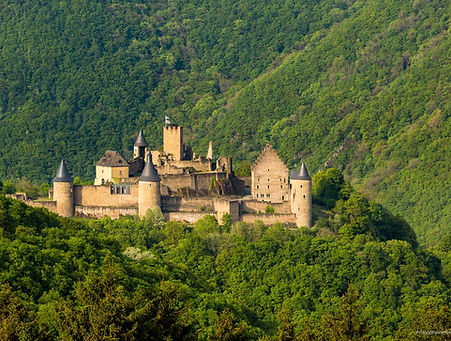
Brandembourg Castle

Located in a picturesque setting in the valley of the River Blees, Brandenbourg Castle has a millennium-long history and served as a residence for the dynasty of Brandenbourg.
Throughout the centuries, the original construction was widely expanded to include a chapel, new towers, cellars, and heavier walls.
La Rochette
A quaint old market town, lying in a narrow rocky valley, entirely surrounded by woods. Larochette is dominated by two old castles (12th century), partially rebuilt, which stand on a rocky crag high above the beautiful and romantic valley of the White Ernz. Medieval square and historic monuments. Old streets. Walks through the woods and countryside are leading to various viewpoints, especially those of the "Manzenbach" connecting Larochette to Meysembourg castle and "Nommerlayen" with the remains of a Roman camp (Aalburg).

Schengen


The historic Luxembourg village where the European Union was born. Located in the magic triangle where Luxembourg and the Benelux countries border Germany and France, Schengen caught the world's attention in June 1985 when it hosted the historic signing of the "Schengen Agreement", formalising the agreement between the original EU countries to abolish border controls between them.
In addition to the many different museums, such as the European Museum, the "A Possen", which deals with wine and folklore, or the Valentiny Foundation, a must for art lovers, the municipality with its green, hilly landscape, lakes, wine villages, nature reserves and gardens also invites you to take a trip in nature. The region offers an exceptional hiking landscape with magnificent views of the Moselle valley, hillside vineyards and exceptional flora and fauna.

The commercial town of Ettelbrück looks back on a long tradition. It attracts visitors not only with its cultural centre and heritage, but also with its variety of modern shops and its attractive pedestrian zone. There is a wide range of hiking and cycling trails in the immediate proximity.
The largest agricultural fair in the region is held in Ettelbrück every year.



